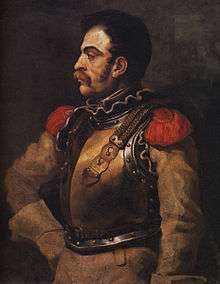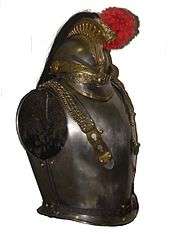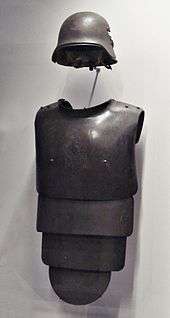Cuirass
A cuirass (/kwɪˈræs, kjʊəˈræs/;[1] French: cuirasse, Latin: coriaceus) is a piece of armor that is formed of a single or multiple pieces of metal or other rigid material which covers the torso. The use of the term "cuirass" generally refers to both the chest plate (or breastplate) and the back piece together. Whereas a chest plate only protects the front and a back plate only protects the back, a cuirass protects both the front and the back.

Description
_01.jpg)
In Hellenistic and Roman times, the musculature of the male torso was idealized in the form of the muscle cuirass[2] or "heroic cuirass" (in French the cuirasse esthétique)[3] sometimes further embellished with symbolic representation in relief, familiar in the Augustus of Prima Porta and other heroic representations in official Roman sculpture. As parts of the actual military equipment of classic antiquity, cuirasses and corsets of bronze, iron, or some other rigid substance were used. Secondary protection for the breast was worn in earlier times by men-at-arms in addition to mail hauberks and reinforced coats. It was not until the 14th century that the plate armor became an established part of medieval armor.
History
The Roman emperor Galba donned a cuirass just before he went to his death. Suetonius records in 12 Caesars that, "As [Galba] was offering sacrifice on the morning before he was killed, a soothsayer warned him again and again to look out for danger, since assassins were not far off. Not long after this he learned that Otho held possession of the camp, and when several advised him to proceed thither as soon as possible – for they said that he could win the day by his presence and prestige – he decided to do no more than hold his present position and strengthen it by getting together a guard of the legionaries, who were encamped in many different quarters of the city. He did however put on a linen cuirass, though he openly declared that it would afford little protection against so many swords."
The latter portion of the 14th century saw the cuirass gradually come into general use in connection with plate armor for the limbs until, at the close of the century, mail was phased out among the nobles (e.g., knights) except in the camail of the bascinet and at the edge of the hauberk. The cuirass was almost universally worn throughout its lifespan as a form of armor. Thus, the globule form of the breast-armor of the Black Prince, in his effigy in Canterbury Cathedral, 1376, intimates that a cuirass (as well as a hauberk) is to be considered to have been covered by the royalty-emblazoned jupon of the Prince.
Historical cuirass, contrary to many modern reproductions, did not rest on the hips. Historical cuirass usually stopped somewhere around the midriff or bellybutton in order to allow a proper range of movement to the wearer. A cuirass ending at the waist would severely limit the ability of the wearer to lean forward, backward or sideways. Thus, to protect the rest of the torso, mail or fauld were used depending on the time period.

Early in the 15th century, plate armor, including the cuirass, began to be worn without any surcoat; but in the concluding quarter of the century the short surcoat, with full short sleeves, known as a "tabard", was in general use over the armor. While the surcoat was being phased out, small plates of various forms and sizes (and not always made in pairs, i.e., the plate for the sword-arm often being smaller and lighter than the one for the off-hand) were attached to the armor in front of the shoulders, to defend the otherwise vulnerable points where the plate defenses left a gap.
About the middle of the century, the breastplate of the cuirass was made in two parts; the lower adjusted to overlap the upper, held together with a strap or sliding rivet in order to add flexibility to the advantages plate armor had over mail. In the second half of the 15th century, the cuirass was occasionally superseded by the brigandine jacket, the medieval forerunner of the flak jacket. In essence, the brigandine jacket was constructed of metal plates sewn into a fabric jacket. The fabric was generally a rich material, and was lined throughout with overlapping scales of metal which were attached to the jacket by rivets, having their heads, like studs, visible on the outside.

About 1550, the breast-piece of the cuirass was characterized by a vertical central ridge, called the tapul, having near its center a projecting point. Somewhat later, the tapul was moved lower on the breast. Eventually, the profile of the plate began to resemble a pea pod and, as such, was referred to as the peascod cuirass. During the English Civil War, only the wealthiest and physically strongest of men could afford this form of armour.
Corslets provided with both breast and back pieces were worn by foot-soldiers in the 17th century, while their mounted comrades were equipped in heavier and stronger cuirasses. These defenses continued in use longer than any other single piece of armor. Their use never altogether ceased and in modern armies mounted cuirassiers, armed as in earlier days with breast and back plates, have in some degree emulated the martial splendour of the body armor of the era of medieval chivalry. Both the French and German heavy cavalry wore cuirasses in parade leading up to World War I. In the early part of that conflict, they painted their cuirasses black and wore canvas protection covers over the neo-Roman style helmets.
Some years after Waterloo, certain historical cuirasses were taken from their repose in the Tower of London and adapted for service by the Life Guards and the Horse Guards. For parade purposes, the Prussian Gardes du Corps and other corps wore cuirasses of richly decorated leather. The Pontifical Swiss Guard still wear cuirasses for swearing in ceremonies, Christmas and Easter.
The Japanese cuirass
Cuirasses were manufactured in Japan as early as the 4th century.[4] Tankō, worn by foot soldiers, and keikō, worn by horsemen, were both pre-samurai types of early Japanese cuirass constructed from iron plates connected by leather thongs. During the Heian period (794 to 1185), Japanese armourers started to use leather as a material and lacquer for weatherproofing.
By the end of the Heian period, the Japanese cuirass had arrived at the shape recognized as part of iconic samurai armor. Scales of iron and leather, bound together by silk lace, were used to construct samurai armors.[5] The introduction of firearms to Japan in 1543 resulted in the development of a cuirass constructed of solid iron plates. The use of the samurai cuirass lasted until the 1860s when a national army using conventional uniforms was established.[6] Samurai armor (and cuirasses) were last used in 1877 during the Satsuma rebellion.[7]
References
- "cuirass". Oxford English Dictionary (3rd ed.). Oxford University Press. September 2005. (Subscription or UK public library membership required.)
- Charlotte R. Long, The Twelve Gods of Greece and Rome (Brill, 1987), p. 184; Elfriede R. Knauer, "Knemides in the East. Some Observations on the Impact of Greek Body Armor on 'Barbarian' Tribes," in Nomodeiktes: Greek Studies in Honor of Martin Ostwald (University of Michigan Press, 1993), pp. 238–239.
- Kenneth Clark remarks on this familiar convention in The Nude: A Study in Ideal Form 1956:67.
- Farris, William Wayne (3 June 1998). "Sacred Texts and Buried Treasures: Issues in the Historical Archaeology of Ancient Japan". University of Hawaii Press. p. 75 – via Google Books.
- Robinson, H. Russell (3 June 2017). "Oriental Armor: By H. Russell Robinson". Courier Corporation. p. 173 – via Google Books.
- Nagayama, Kōkan (3 June 1997). "The Connoisseur's Book of Japanese Swords". Kodansha International. p. 43 – via Google Books.
- Samurai: The Weapons and Spirit of the Japanese Warrior, Clive Sinclaire, Globe Pequot, 2004, page 58.
- Sources

